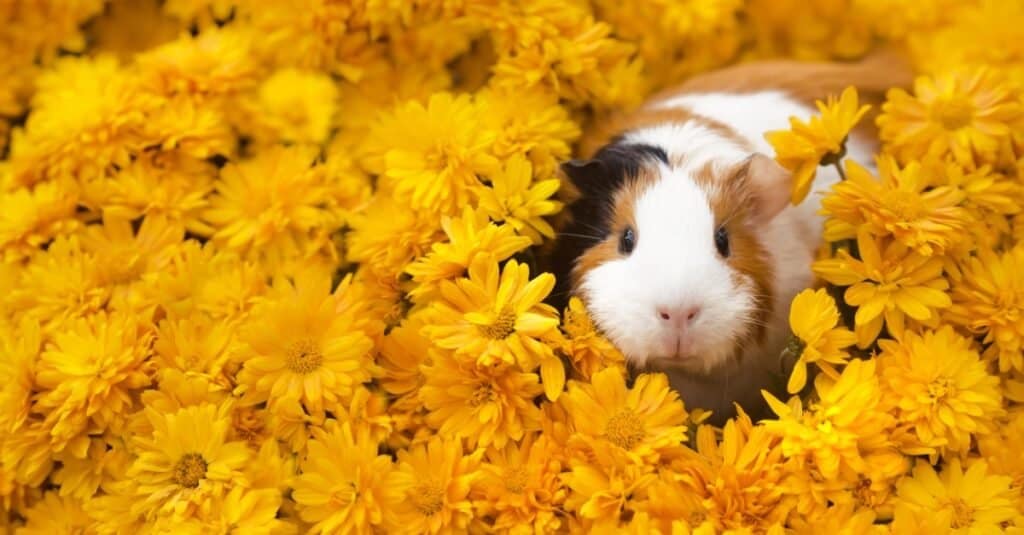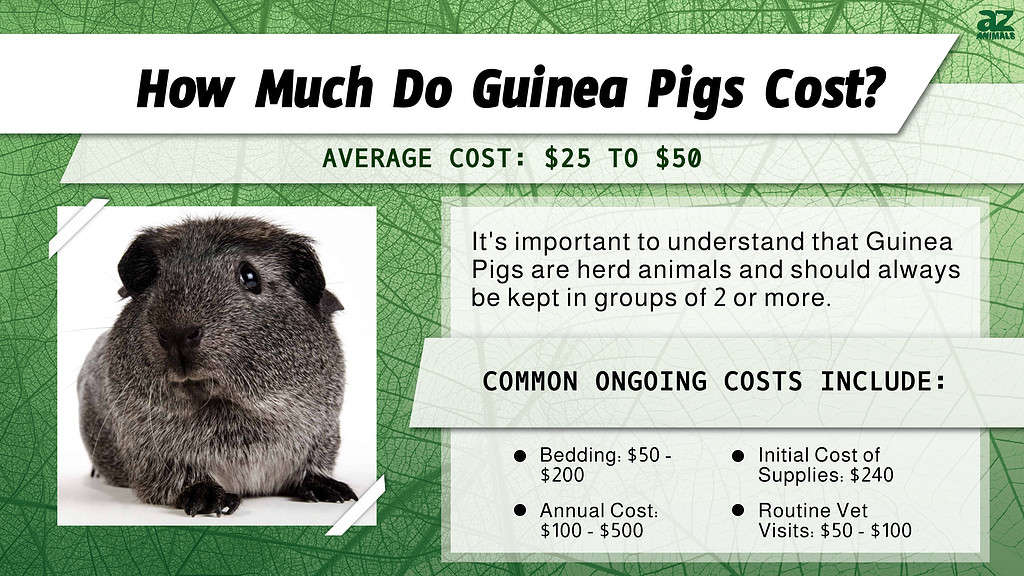If you want a great pet that requires minimal maintenance and cost, go with a guinea pig. They live longer than other rodents and happen to be a lot cuter. These animals can be extremely vocal, have unique personalities, and develop great attachments to loved ones.
The guinea pig is sweet and affectionate. These animals are social and will be happier if they can cohabitate with other cavies (as guinea pigs are often called). If you don’t want a litter of guinea pigs, keep same-sex pets. But you want to introduce them as babies for better cohabitation.
Read on to learn more about owning and how to care for a guinea pig.
General Info
Originally from South America, it’s believed guinea pigs came to Europe shortly during the 1500s Spanish explorations. The animals became popular pets at the time. Today, that remains so. They are also bred as show animals.
There are three popular breeds among the dozen or so species. They are:
- English or common guinea pigs with fine, straight, short hair.
- Peruvians have long, silky, straight hair.
- The Abyssinian has coarse hair that grows in whorls or rosettes.
These animals come in a range of patterns and colors. There’s also the “skinny pig,” a hairless breed. Females are sows while males are boars. The guinea pig’s weight can go between 1.5 to 2.5 pounds. They grow between eight to 16 inches.
Generally, guinea pigs live five to eight years. Some live up to a decade. They have scent glands along the base of their tails and over their backs. As they age, they can become plastered with secretions. It can make their skin appear greasy.
The creatures have three toes in the back and four toes on their front feet.

©Dev_Maryna/Shutterstock.com
Pros and Cons of Taking Care of a Guinea Pig
Guinea pigs make for charming pets. They’re cuddly and textured and can be fun to just watch. But that doesn’t mean owning one of these creatures is a slice of heaven. Here are some considerations on both sides of the fence when owning and caring for a guinea pig:
| Pros! | Cons! |
|---|---|
| A guinea pig’s dietary needs are pretty straightforward. | Guinea pigs are small and easily harmed by falls or physical mistreatment. Thus, small children should not play with these pets. |
| They are ideal pets for small children. | Guinea pigs are often classified as “colorful” and unique. Vets may charge a nice fee for their care. |
| Guinea pigs aren’t subject to significant diseases. | You may need to supplement the animal’s diet to compensate for a tendency for vitamin C deficiency. It may also need nutrient-rich soil. |
| They’re affectionate creatures, forming family relationships and loving exploring the house. | A well-bred guinea pig won’t be a problem but they are susceptible to worms and parasites. |
| The guinea pig is a fairly obedient animal, comfortable with schedules and being left alone. | When enclosures aren’t managed, they and the animal can create unpleasant odors. |
| As small animals, their cages are mobile. | They may be a little noisy at night. |
| Cages should be nice sized but are still flexible when it comes to placement. | |
| Guinea pigs combine the cat’s warm nature and the wonders of watching fish. | |
| They are an affordable option, not requiring a lot of food, and accessories, such as wheels, are relatively inexpensive. | |
| Unlike gerbils, hamsters, mice, or rats, guinea pigs are not known for biting. | |
| The pets aren’t messy, making it relatively easy to keep their cages maintained. |
Temperament
The guinea pig is a friendly, easy-going creature. It has the energy to spare and is both clingy and outgoing. And it doesn’t bite.
As herd animals, they’re happiest around companions and it’s a good idea to keep more than one in a cage. It’s good around other animals too. Extremely intelligent, you can train a guinea pig to perform tricks.
The animal will make an ideal first pet for an older child. The guinea pig pretty much only needs one feed a day and cleaning of its crate from time to time. Otherwise, be ready to enjoy the critter with petting, playing, cuddling, exercising, and training.
Dietary Requirements
Your guinea pig needs a steady diet of clean, high-quality timothy hay. The food wears down their teeth (which continues to grow all through the guinea pig’s life). It’s also high in fiber, ensuring the animal has a healthy digestive system.
A guinea pig’s diet is at its best when it takes in 20 percent of its body weight each day. It’s recommended that the animal gets one cup daily. Vegetables should be a majority of greens. You want portions of colored veggies to ensure the animal gets its vitamin C. Make sure the food’s fresh as vitamin C dries up quickly.
The animal can also benefit from food pellets and fruit. They need between one-fourth and one-eighth vitamin C fortified pellets a day. Find them in a pet store or online. Again, regarding vitamin C, keep fruit fresh.
Guinea pigs must also be given vitamin C supplements daily since the quantities provided in their food are simply not enough. It is important that the medication be administered orally.
Failure to provide them with the vitamin may result in symptoms such as swollen feet, sore gums, and a rough coat. Additional issues may also include diarrhea and joint pain.
Should you notice any of these symptoms in your pet, you should get them medical attention as soon as possible.
Caring for Your Guinea Pig
Here are the basic tools you need for caring for your guinea pig:
- Solid-bottom cage at least 24 x 12 x 12 inches
- Food bowl
- Hide house (small flower pot or store-bought)
- Water bottle
- Hack rack
- Chew toys
- Pine, aspen or recycled bedding (cedar’s toxic for cavies)
- Orchard grass, oat grass or (preferred) timothy hay
If you want your new pet to take to its new home right off, have the habitat ready. Toys and treats and bedding should all be in place in a secluded, calm spot away from larger pets.
Guinea pigs love coddling but let the first day be settling in time. If they react shyly to petting, give the rodents a little space to acclimate, perhaps for about 15 minutes, before trying again.
Grooming and Playtime
These animals can’t stop foraging. They love it! Toys that stand up to good chewing and (better) hide treats are great resources. Also, guinea pigs need to roam every day. So let them out of their cages and let them scurry around a large, safe space. Keep an eye out as they’ll chew on almost anything, including electrical wires. If you choose to let them outdoors, keep track of them at all times. As a rodent, you can blink and won’t know where they are.
Including the occasional haircut in your pet’s grooming is a good idea. But you need to do it carefully and only if the animal’s comfortable. You can use manual or electric clippers. Manual may be better as electric clippers may startle some. (Though may guinea pigs have a problem with the noise.)
Not letting their hair go wild is a way to ensure good health. Knotted hair is uncomfortable for most animals. Grooming long hair almost ensures your pet overheats, gets urinary tract infections, or absorbs moisture and waste from their cages.

©Evgeniya Grande/Shutterstock.com
Watch Out for Allergies
There are people who are allergic to guinea pigs. People may react to the proteins in the creature’s urine or saliva. The rumor that guinea pigs contribute to dander and other air pollutants is largely untrue. Mostly, they transmit allergens through handling or close contact. Their hay and wood shavings may also contribute to allergic reactions.
If you’re not sure how anyone in the home will react, spend time with a guinea pig. Visit a household where one lives or visit a farm or zoo that keeps them. Go to a pet store or a local humane society or rescue group. These are great ways to see if you can be around guinea pigs.
Caging: Size Matters
Many pet lovers love to buy cute, tiny little critters and they think those suitably sized cages are such adorable accessories. Owners often don’t take into account a guinea pig will grow into a large rodent. Much larger than gerbils or hamsters. And typical cages get exponentially smaller as the animal grows.
Your cage should utilize vertical space. It should encourage digging, climbing, burrowing, and hiding. Low-level ramps and platforms are great for exercise and daily play, on top of daily roaming outside the cage.
The sides of the enclosure should be at least 12 inches high. Tops can be open as long as you’re sure the pet can’t get out. Floors should be solid. Rescue organizations suggest enclosures made out of coroplast and cubes. Glass aquariums, plastic tubes, and wire floors are unacceptable.
Adequate room is also healthy. The roomier enclosure and effective movement minimize diabetes, heart disease, bumblefoot, and anal issues.
The more guinea pigs you have, the larger the cage. Instead of upgrading as the animal grows, just start with a nice cage. Just remember these animals love to exercise. The toys may have to change over time. You don’t want to overwhelm the smaller creatures nor do you want to underwhelm the larger ones. And trust, when we say seeing a bored guinea pig, will make you as unhappy as they are.
How Much Does a Pet Guinea Pig Cost?

If you don’t yet own guinea pigs, but are considering becoming a proud parent, there are costs to factor in from buying your initial pet(s) to getting them set up to lead happy, healthy lives.
A single guinea pig averages $25-$50 unless it’s a rare or show-quality animal. However, as guinea pigs are herd animals, you’ll need to think of a minimum of two. A proper enclosure should measure at least 30” x 50” to house two animals, averaging $85. Ongoing items like bedding, food, and treats can cost up to $75 monthly, while set-up supplies like water bottles and feeding bowls, a hiding hut for each, and toys could cost up to $100. Other costs would include routine veterinary visits, which can range from $50-$100.
The photo featured at the top of this post is © iStock.com/sobakabarobaka
Thank you for reading! Have some feedback for us? Contact the AZ Animals editorial team.






